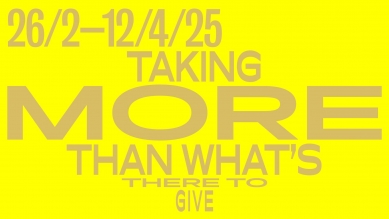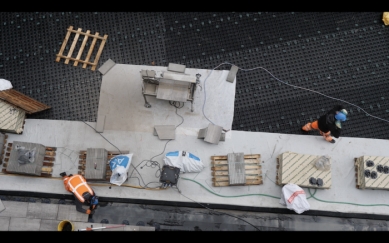
Taking More Than What's There to Give - exhibition at Gallery VI PER
Source
Galerie VI PER
Galerie VI PER
Publisher
Tisková zpráva
23.02.2025 10:50
Tisková zpráva
23.02.2025 10:50
Exhibitions
Czech Republic
Prague
Karlín
Galerie VI PER cordially invites you to the opening of the exhibition Taking More Than What's There to Give and a guided tour with the curator of the exhibition, Alina Paias.
In current architectural creation, it is still common to rely on various forms of extraction. Therefore, a number of designers and researchers are trying to define and facilitate processes that would free architectural practice from its necessary dependence on extraction. As these concerns penetrate mainstream thinking, the question arises as to what other forms of extraction are the basis of architectural production. Energy is a fundamental part of this inquiry: the term embodied energy is often used as one way to assess the impact of a particular building on the environment, describing a form of energy debt: the sum of all energy consumed during the life cycle of a building or any of its components, from the extraction of raw materials to waste disposal. This calculation captures the understanding that the movement, transformation, and dispersion of energy support the creation of architecture. Energy is a vital and fundamental factor from the extraction of raw materials to the extraction of value, specifically surplus value, through mobilizing labor on construction sites and in architectural offices.
The presented exhibition, firmly rooted in these reflections, explores the close relationship between energy, labor, and value in the creation of architecture and the built environment. Once it becomes clear that energy represents the material basis for value, maximizing value expresses the maximization of energy consumption. The creation of architecture then takes place on the brink of overexploitation, and sometimes even exceeds this limit, taking more than can possibly be given.
The exhibition gathers research, stories of specific places, as well as unanswered questions and promising alternative paths. The section titled Economies of Architecture presents research from various corners of the planet revealing relationships between extraction, energy consumption, and value maximization. It includes a mine where architecture relies on the extraction of raw materials and energy while simultaneously supporting it; furthermore, it illustrates a factory where environmental impacts go hand in hand with hazardous working conditions; subsequently, it presents infrastructure, where all energy flows spatially materialize in the form of workers and materials; a construction site as a focal point of architectural production and a primary site of surplus value extraction; a studio where the monetization of architecture directly influences the way architects work; and finally, an inhabited building, where all these conditions converge and the building is subsequently consumed.
The work of the scholars of the European Architecture Platform LINA, straddling Prague and Lisbon, where the exhibition is taking place in parallel, addresses inhabited architecture as an energy consumer, speculative cartography of resource depletion dynamics in Europe, and networks of solidarity among construction workers in the fight against the climate crisis. The exhibition concludes with the video The Void of Its Other, which examines the financial and political pressures and incentives that shape housing construction in contemporary Rotterdam.
Exhibitors: Alfonse Chiu & Emma Kaufmann LaDuc, Alina Paias & Benjamin Schoonenberg, Angela Gigliotti, Belgian Architects United, Evelina Gambino & Jess Gough, Jean Souviron, Laura Pappalardo, Lesia Topolnyk, Liam Ross, Netherlands Angry Architects!, Paulien Bremmer, Serah Calitz, Sergio Kopinski Ekerman.
Curator: Alina Paias
Alina Paias is an architect, publicist, and curator who focuses on technologies and forms of knowledge in architectural creation while employing a wide range of philosophical approaches. She was one of the curators of the International Architecture Biennale 2024 in Rotterdam with the title Nature of Hope and is a member of the editorial team of the architectural theory journal Footprint, published by Delft University of Technology (TU Delft).
The exhibition was created as part of the LINA European Architecture Platform program and in collaboration with the Lisbon Architecture Triennale, where the exhibition will take place from 8/3–13/5/2025.
Alina Paias is an architect, publicist, and curator who focuses on technologies and forms of knowledge in architectural creation while employing a wide range of philosophical approaches. She was one of the curators of the International Architecture Biennale 2024 in Rotterdam with the title Nature of Hope and is a member of the editorial team of the architectural theory journal Footprint, published by Delft University of Technology (TU Delft).
The exhibition was created as part of the LINA European Architecture Platform program and in collaboration with the Lisbon Architecture Triennale, where the exhibition will take place from 8/3–13/5/2025.
The English translation is powered by AI tool. Switch to Czech to view the original text source.


0 comments
add comment












